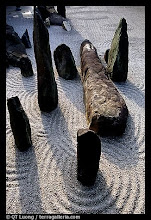
Been wanting to visit the Nasher since it opened in Dallas next door to the DMOA but have not had an opportunity to catch it open - until yesterday. A beautiful spring day, not too many people, and it did not disappoint. The building by Renzo Piano is terrific enough, with all the subtle classical / contemporary beauty and subdued natural lighting of Kahn's Kimball in Ft.Worth. Not as astounding to me personally as Ando's Ft. Worth Modern but still I really appreciated the restraint and deference of the building to the collection. The grounds are pristine; some of the varieties of trees are sculpture in themselves. A boardwalk under a huge weeping willow is its own environment. I'm partial to bamboo anyway and long screens of manicured bamboo in gray river rock beds are to drool over.

I especially wanted to see Turrel's commissioned skyspace. Basically just a small room with a hole in the roof. But what a hole. He's done quite a few of these now and the premise is that a paper thinned edge reveals a patch of sky from below as a plane on the ceiling. Unless there are some reference points like clouds, a plane passing by, etc. it is impossible to tie down exactly what it is you are seeing. It doesn't look like blue sky but some strange new velvety material you've never seen. The execution is almost - but not quite - perfect. Unfortunately, conceptual things like this need to be perfect to even have a reason to exist. The sky yesterday was an average bright, light blue. The edges of the hole are thin but still visible, open joints in the interior of the minimalist room necessary for rainwater drainage and subtle holes for security cameras are small but still are distracting in Hi-rez real life reality. Later in the day as the sky color deepens and in "golden minutes of opportunity" it must be really memorable. In actuality it photographs beautifully even by hacks like me with a point and shoot camera. Maybe losing the 3rd dimension heightens the way that a simple hole in the roof reads as a whole 'nother entity. It requires a shift of perception to appreciate. Genius or stupidity depending on your point of view. Worth another visit to see in different conditions.
The thing that impressed me the most about the visit was that it is obvious that millions were spent on the site, the building, and the collection yet the art is extremely accessible. No rope barriers surround the pieces. Guards were posted all over but were friendly. Walking on the grass and through the negative spaces of several of the larger sculptures is actually encouraged. Signs said no food and drink or flash photography but still photos and sketching of the pieces by students are welcome. Families with small kids were all over and as I left a large group of small kids showed up and were met with smiles by the staff instead of expressions of terror. A temporary piece is of a virtual solid curtain of floating stainless steel text hanging by thin lines that completely cut the building down the middle; there was no way to get to the other side without pushing your way through the piece like a walk through wind chime. To me, the concept of the piece by a south american artist was highbrow and irrelevant. The fact that visitors and children could actually touch it, make it tinkle and were basically forced to interact with it was really refreshing. Small signs discouraged touching of the bronzes for obvious tarnishing reasons and I'm sure climbing on anything by little heathens would be quickly dealt with too but all in all the center has a nicely laid back presentation.

Out in the garden I was appreciating an up-close look at a Richard Serra pair of arcing steel slabs, wondering how in the hell slabs of steel so massive can be formed, handled, shipped cross-country and then placed so delicately in balance with each other. I especially liked the fact that tong marks along the top edge of the bent plates are evidence of it's foundry birth and were left in place. The logistics of things like that will totally escape 95% of people. I was starting to walk through the narrow space between the steel walls when two little girls ran up wide-eyed and asked "Can we go in there?!" I said, "Oh yea, your supposed to!" pointing out the gravel walkway between. Being familiar with the acoustics inherent in his sculptures (the piece in Ft. Worth has amazing reverberant echos) I added "When you get to the middle you have to yell real loud." They gave me a leery eye but ran full throttle through the void squealing. Their parents met them at the other end with their mouths hanging open. The two little rats pointed me out; "You have to be real loud, HE said your sposed to!" Ahh... yes. I just shrugged my shoulders and laughed.
Note to artists: Please cut through all the crap, no art should take itself too serious if it is ever going to be really appreciated with joy. Check it out.













